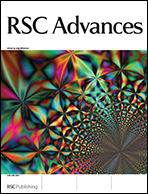Low-temperature synthesis of stable nanoTiO2–rGO composite colloids and their application in photoelectric films†
Abstract
It is found that low-temperature synthesized nanoTiO2 particles and reduced graphene oxide (rGO) would make up for each other's shortcomings: on the one hand, negatively charged nanoTiO2 particles could obviously enhance the dispersion of rGO. The nanoTiO2–rGO colloid synthesized at a low temperature (95 °C) remained stable for at least 6 months; on the other hand, for the ultrathin and transparent nanoTiO2–rGO films prepared using this stable colloid, rGO loading could enhance the connection of the nanoTiO2 particles and the substrate and therefore effectively increase the photocurrent to 4.8 times more than the photocurrent generated by pure nanoTiO2. The as-prepared transparent flexible film can be shaped into triangular calandrias which could make full use of the incident UV light, and thus increase the removal efficiency from the pass through of gas-phase


 Please wait while we load your content...
Please wait while we load your content...